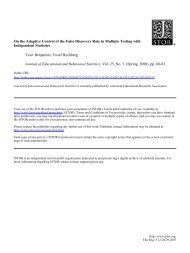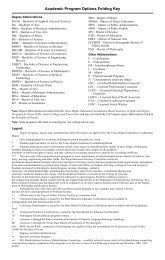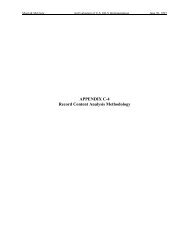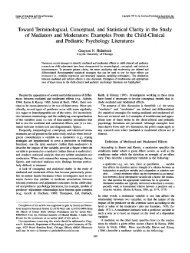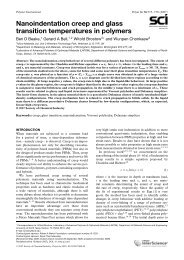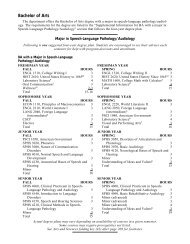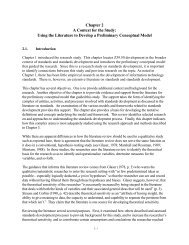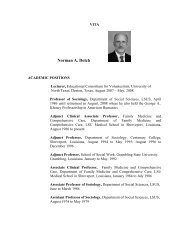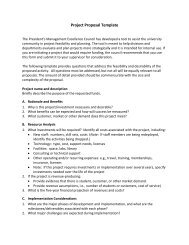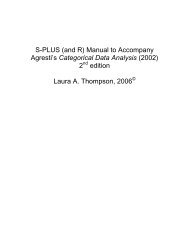A brief reminder about Sample Size
A brief reminder about Sample Size
A brief reminder about Sample Size
Create successful ePaper yourself
Turn your PDF publications into a flip-book with our unique Google optimized e-Paper software.
A <strong>brief</strong> <strong>reminder</strong> <strong>about</strong> <strong>Sample</strong> <strong>Size</strong><br />
As published in Benchmarks RSS Matters, March 2012<br />
http://web3.unt.edu/benchmarks/issues/2012/03/rss-matters<br />
Jon Starkweather, PhD<br />
1
Jon Starkweather, PhD<br />
jonathan.starkweather@unt.edu<br />
Consultant<br />
Research and Statistical Support<br />
http://www.unt.edu<br />
http://www.unt.edu/rss<br />
RSS hosts a number of “Short Courses”.<br />
A list of them is available at:<br />
http://www.unt.edu/rss/Instructional.htm<br />
2
A <strong>brief</strong> <strong>reminder</strong> <strong>about</strong> <strong>Sample</strong> <strong>Size</strong><br />
We’ve all heard (or spoken) questions similar to those below. How many voters should I poll<br />
to get an idea of who will win the election? What sample size do I need to determine whether<br />
people prefer green M&M’s over red? How many undergraduates should I collect data from to<br />
determine if my model of retention is meaningful or predictive? How many people should I survey<br />
to measure satisfaction with my new product? How many mice should I assign to each condition<br />
of my experiment? How many protein samples should I extract from each person in order to create<br />
a composite protein estimate of each person? These are good questions. However, easy answers<br />
do not often follow good questions. The above questions all relate to the issue of sample size and<br />
much has been said on the subject. In this issue I’ll provide some highlights for your consideration.<br />
This paragraph contains information you likely are aware of, but (alas); I’m compelled by<br />
my professional conscience to type it. Generally it is suggested that questions of sample size be<br />
addressed prior to proposing a study (e.g. as a student; prior to thesis/dissertation proposal & as a<br />
faculty/professional researcher; prior to IRB and grant application). Typically during discussions<br />
of study design or methodology the issue of sample size should be addressed – because sample<br />
size is directly linked to statistical power and external validity. Post hoc power estimates are<br />
virtually useless. Generally, it is recommended that an a-priori power analysis be computed (using<br />
a desired level of power, desired effect size, desired error rate, and known/proposed number of<br />
parameters, variables, or conditions); which will produce a sample size estimate which in turn<br />
gives the researcher a target sample size which is likely to achieve the specified levels of power<br />
and effect size for a given error rate and design. We (RSS) like to recommend using G*Power 3<br />
(which is a free download 1 ) or any one of several R packages designed for this task. In conducting<br />
a-priori power analysis, it is important to remember what statistical power actually is: the ability<br />
to detect an effect if one exists (in formula: power = 1 - ?). Or, if you prefer, as Cohen (1988) put<br />
it: “the power of a statistical test is the probability that it will yield statistically significant results”<br />
(p. 1).<br />
The most general, and flippant, guideline for sample sizes often tossed around is “you need<br />
to have more cases/participants than you have parameters/variables/questions.” The next most<br />
stringent phrase you are likely to hear, often associated with a ’step’ from descriptive statistics<br />
to inferential statistics, is “you need to have at least 5 to 10 cases/participants for each parameter/variable/question.”<br />
Next, often associated with a ’step’ from fairly straightforward inferential<br />
techniques (t-test, ANOVA, linear [OLS] regression...) to multivariate statistical techniques is “you<br />
need at least 25 (up to 150) cases/participants for each parameter/variable/question.” These types<br />
of heuristics, although they make nice quick sound-bite answers, are not terribly useful because;<br />
real consideration must be taken with respect to a variety of issues. The first issue to consider<br />
is the statistical perspective one is planning on taking with the data, will a Bayesian perspective<br />
be used or a Frequentist perspective. Generally speaking, Bayesian analyses handle small sample<br />
sizes better than analogous Frequentist analyses, largely because of the incorporation of a prior. A<br />
Bayesian perspective also allows one to use sequential testing; implementation of a stopping rule<br />
(Goodman, 1999a; Goodman, 1999b; Cornfield, 1966). Other considerations include, what types<br />
of hypothesis (-es) one is attempting to test, what type of phenomena is being statistically modeled,<br />
the size of the population one is sampling from (as well as its diversity), and (certainly not<br />
1 http://www.psycho.uni-duesseldorf.de/abteilungen/aap/gpower3/<br />
3
least) the type of analysis one expects to conduct. Some analyses inherently have more power than<br />
others (e.g., see discriminant function analysis vs. multinomial logistic regression). Furthermore,<br />
one must consider the assumptions of the analysis one is expecting to run. Often data collected<br />
does not conform to the assumptions of a proposed analysis and therefore, an alternative analysis<br />
must be chosen - one which will provide analogous statistics for addressing the hypothesis or<br />
research question posed; but, the alternative often has less power. Another consideration is this;<br />
it is well accepted that point estimates (e.g., mean, median, model parameters; such as regression<br />
coefficients) are fairly stable and fairly accurate even with relatively small sample sizes. The problem<br />
(again, well accepted) is that interval estimates (e.g., confidence intervals) will not be terribly<br />
accurate with small samples; often the standard errors will be biased. The only real answer is;<br />
larger samples are better than smaller samples...<br />
Contrary to much of the above considerations; some modern methods (e.g., optimal scaling,<br />
resampling) can be used to overcome some of the pitfalls of a small sample. However, many people<br />
are suspicious of these modern methods and they can be quite controversial (e.g. if a journal editor<br />
or reviewer has never heard of optimal scaling, how likely do you think you are to get the study<br />
published in their journal?). These methods are genuinely controversial because they often assume<br />
a particular position or belief <strong>about</strong> something – for instance, people who use optimal scaling with<br />
survey data have particular beliefs <strong>about</strong> the characteristics and properties of survey measurement;<br />
which others, of equal professional respect, disagree with or hold opposing beliefs.<br />
Lastly, with respect to sample size, using new measures/instruments (ones which have not<br />
been validated nor had their psychometric properties established/accepted) should motivate the<br />
collection of large samples. The larger sample can be divided into 2 or more subsamples so one<br />
subsample can be used for validation or confirmatory analysis, while the other subsample(s) can<br />
be used to fit the hypothesized models.<br />
We (RSS) have a rule that the study author(s) or primary investigator(s) should be the one(s) to<br />
make decisions regarding what is done and we want those decisions to be as informed as possible<br />
by providing as much (often called too much) information as we can. Therefore, we will not<br />
provide ’easy’ answers to questions of sample size. The amount of data collected for any empirical<br />
study should be based on critical thought, on the part of the study authors, directed toward the<br />
considerations mentioned in this article. The best two pieces of advice on the subject of sample<br />
size are; start to think <strong>about</strong> sample size very early (i.e. long before data collection begins) and<br />
collect as much data as you possibly can.<br />
Until next time, don’t play The Lottery with Shirley Jackson<br />
4
References & Resources<br />
Cohen, J. (1988). tatistical Power Analysis for the Behavioral Sciences (2nd ed.). Hillsdale, NJ:<br />
Lawrence Erlbaum Associates.<br />
Cornfield, J. (1966). A Bayesian test of some classical hypotheses, with applications to sequential<br />
clinical trials. Journal of the American Statistical Association, 61, 577 - 594. Available at JSTOR:<br />
http://www.jstor.org/stable/10.2307/2282772<br />
Erdfelder, E., Faul, F., & Buchner, A. (1996). GPOWER: A general power analysis program.<br />
Behavior Research Methods, Instruments & Computers, 28, 1-11. Available at:<br />
http://www.psycho.uni-duesseldorf.de/abteilungen/aap/gpower3/literature<br />
Goodman, S. (1999a). Toward evidence-based medical statistics, 1: The p value fallacy. Annals of<br />
Internal Medicine, 130(12), 995 - 1004. Available at:<br />
http://psg-mac43.ucsf.edu/ticr/syllabus/courses/4/2003/11/13/Lecture/read<br />
Goodman, S. (1999b). Toward evidence-based medical<br />
statistics, 2: The Bayes factor. Annals of Internal Medicine, 130(12), 1005 - 1013. Available at:<br />
http://psg-mac43.ucsf.edu/ticr/syllabus/courses/4/2003/11/13/Lecture/read<br />
Herrington, R. (2002). Controlling False Discovery Rate in Multiple Hypothesis Testing.<br />
http://www.unt.edu/benchmarks/archives/2002/april02/rss.htm<br />
Herrington, R. (2001). The Calculation of Statistical Power Using the Percentile Bootstrap and<br />
Robust Estimation.<br />
http://www.unt.edu/benchmarks/archives/2001/september01/rss.htm<br />
Jeffreys, H. (1948). Theory of probability (2nd ed.). London: Oxford University Press.<br />
Price, P. (2000). The 2000 American Psychological Society Meeting. http://www.unt.edu/benchmark<br />
This article was last updated on March 12, 2012.<br />
This document was created using L A TEX<br />
5



